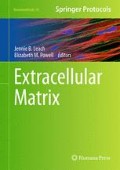Abstract
Traditional in vitro chemotaxis tools are typically limited by unstable concentration gradients, presence of hydrodynamic shear, and the inability to decouple cell migration directionality and speed. These limitations have restricted the reproducible and quantitative analysis of neuronal migration, which is a requirement for mechanism-based studies that may guide the development of new therapeutic strategies for neural regeneration. Here we describe a microfluidic setup for creating stable, linear, and shear-free gradients of putative chemotactic cues and their application in quantifying chemotaxis (i.e., migration directionality) and migration speed of human neural progenitor cells (NPCs). These devices can be coated with various extracellular matrix (ECM) proteins for the study of two-dimensional (2D) migration or filled with ECM hydrogels (e.g., collagen I or Matrigel) for the study of three-dimensional (3D) migration.
Access this chapter
Tax calculation will be finalised at checkout
Purchases are for personal use only
References
Andres RH et al (2011) The CCR2/CCL2 interaction mediates the transendothelial recruitment of intravascularly delivered neural stem cells to the ischemic brain. Stroke 42(10):2923–2931
Gage FH (2000) Mammalian neural stem cells. Science 287(5457):1433–1438
Imitola J et al (2004) Directed migration of neural stem cells to sites of CNS injury by the stromal cell-derived factor 1alpha/CXC chemokine receptor 4 pathway. Proc Natl Acad Sci U S A 101(52):18117–18122
Adler J (1966) Chemotaxis in bacteria. Science 153(3737):708–716
Hartmann TN et al (2008) A crosstalk between intracellular CXCR7 and CXCR4 involved in rapid CXCL12-triggered integrin activation but not in chemokine-triggered motility of human T lymphocytes and CD34+ cells. J Leukoc Biol 84(4):1130–1140
Kokovay E et al (2010) Adult SVZ lineage cells home to and leave the vascular niche via differential responses to SDF1/CXCR4 signaling. Cell Stem Cell 7(2):163–173
Zigmond SH (1988) Orientation chamber in chemotaxis. Methods Enzymol 162:65–72
Zicha D, Dunn G, Jones G (1997) Analyzing chemotaxis using the Dunn direct-viewing chamber. Methods Mol Biol 75:449–457
Keenan TM, Hsu C-H, Folch A (2006) Microfluidic ``jets'' for generating steady-state gradients of soluble molecules on open surfaces. Appl Phys Lett 89(11):114103
Bhattacharjee N et al (2010) A neuron-benign microfluidic gradient generator for studying the response of mammalian neurons towards axon guidance factors. Integr Biol 2(11–12):669–679
Chung BG, Lin F, Jeon NL (2006) A microfluidic multi-injector for gradient generation. Lab Chip 6(6):764–768
Dertinger SKW et al (2001) Generation of gradients having complex shapes using microfluidic networks. Anal Chem 73(6):1240–1246
Chung BG et al (2005) Human neural stem cell growth and differentiation in a gradient-generating microfluidic device. Lab Chip 5(4):401–406
Jeon NL et al (2000) Generation of solution and surface gradients using microfluidic systems. Langmuir 16(22):8311–8316
Joanne Wang C et al (2008) A microfluidics-based turning assay reveals complex growth cone responses to integrated gradients of substrate-bound ECM molecules and diffusible guidance cues. Lab Chip 8(2):227–237
Urbich C et al (2002) Shear stress-induced endothelial cell migration involves integrin signaling via the fibronectin receptor subunits alpha(5) and beta(1). Arterioscler Thromb Vasc Biol 22(1):69–75
Wojciak-Stothard B, Ridley AJ (2003) Shear stress-induced endothelial cell polarization is mediated by Rho and Rac but not Cdc42 or PI 3-kinases. J Cell Biol 161(2):429–439
Walker GM et al (2005) Effects of flow and diffusion on chemotaxis studies in a microfabricated gradient generator. Lab Chip 5(6):611–618
Saadi W et al (2007) Generation of stable concentration gradients in 2D and 3D environments using a microfluidic ladder chamber. Biomed Microdevices 9(5):627–635
Breckenridge MT, Egelhoff TT, Baskaran H (2010) A microfluidic imaging chamber for the direct observation of chemotactic transmigration. Biomed Microdevices 12(3):543–553
Irimia D et al (2007) Polar stimulation and constrained cell migration in microfluidic channels. Lab Chip 7(12):1783–1790
Paliwal S et al (2007) MAPK-mediated bimodal gene expression and adaptive gradient sensing in yeast. Nature 446(7131):46–51
Xu H, Heilshorn SC (2012) Microfluidic investigation of BDNF-enhanced neural stem cell chemotaxis in CXCL12 gradients. Small 9(4):585–595
Shamloo A et al (2008) Endothelial cell polarization and chemotaxis in a microfluidic device. Lab Chip 8(8):1292–1299
Kuhnert F et al (2010) Essential regulation of CNS angiogenesis by the orphan G protein-coupled receptor GPR124. Science 330(6006):985–989
Shamloo A, Xu H, Heilshorn S (2012) Mechanisms of vascular endothelial growth factor-induced pathfinding by endothelial sprouts in biomaterials. Tissue Eng Part A 18(3–4):320–330
Haddox JL et al (1994) Characterization of chemical gradients in the collagen gel-visual chemotactic assay. J Immunol Methods 171(1):1–14
Cao X, Shoichet MS (2001) Defining the concentration gradient of nerve growth factor for guided neurite outgrowth. Neuroscience 103(3):831–840
Wong AP et al (2008) Partitioning microfluidic channels with hydrogel to construct tunable 3-D cellular microenvironments. Biomaterials 29(12):1853–1861
Cheng S-Y et al (2007) A hydrogel-based microfluidic device for the studies of directed cell migration. Lab Chip 7(6):763–769
Wu H, Huang B, Zare RN (2006) Generation of complex, static solution gradients in microfluidic channels. J Am Chem Soc 128(13):4194–4195
Abhyankar VV et al (2006) Characterization of a membrane-based gradient generator for use in cell-signaling studies. Lab Chip 6(3):389–393
Diao J et al (2006) A three-channel microfluidic device for generating static linear gradients and its application to the quantitative analysis of bacterial chemotaxis. Lab Chip 6(3):381–388
Millet LJ et al (2010) Guiding neuron development with planar surface gradients of substrate cues deposited using microfluidic devices. Lab Chip 10(12):1525–1535
Acknowledgment
Work was supported by NIH 1T32-HL098049-01A1 to the Stanford Cardiovascular Institute (H.X.), NIH R21-AR062359-01, and 1DP2-OD006477-01 (S.C.H.).
Author information
Authors and Affiliations
Corresponding author
Editor information
Editors and Affiliations
Rights and permissions
Copyright information
© 2015 Springer Science+Business Media New York
About this protocol
Cite this protocol
Xu, H., Heilshorn, S.C. (2015). Engineered Microdevices to Study and Manipulate Neural Stem Cell Chemotaxis. In: Leach, J., Powell, E. (eds) Extracellular Matrix. Neuromethods, vol 93. Humana Press, New York, NY. https://doi.org/10.1007/978-1-4939-2083-9_16
Download citation
DOI: https://doi.org/10.1007/978-1-4939-2083-9_16
Published:
Publisher Name: Humana Press, New York, NY
Print ISBN: 978-1-4939-2082-2
Online ISBN: 978-1-4939-2083-9
eBook Packages: Springer Protocols

